What Is Viral Metagenomics
A virus is a non-cellular organism of microscopic dimensions and simple structure, that contains a single type of nucleic acid, either DNA or RNA. In order to proliferate, viruses necessitate a parasitic existence within living cells, appropriating their host's machinery for replication. Viruses stand as the most abundant "biological" entities on Earth, pervading all known ecosystems—from aquatic environments and soil matrices to the human body, their ubiquity is unchallenged. Additionally, the capacity of viruses to infect all known types of organisms is universally recognized, encompassing fauna, flora, and microbes, inclusive of bacteria and archaea.
Viral Metagenomics, a burgeoning discipline anchored in the principles of metagenomics and bolstered by contemporary virus molecular biology detection methods, takes an all-inclusive approach to viral research. It directly targets all viral genetic material present in a sample— an assemblage typically referred to as the "Virome"— offering a swift and precise identification of all constituent viruses within the sample. This branch of science boasts diverse applicability, extending its reach to human or animal gut or blood samples, water and soil samples, to name a few. Not only does it play a pivotal role in various areas of research such as virus discovery, virus tracing, and microbial warning, but it also holds great significance in exploring the origins and evolution patterns of viruses, their genetic diversity, and geographical distribution.
Research into viral metagenomics commenced in 2002 when Bretbart and colleagues utilized metagenomic technologies to study two uncultivated marine viral communities, identifying bacteriophages as the main viral type in seawater. Recently, viral metagenomics research has undergone explosive growth as the role of viruses in regulating microbial ecological balance is increasingly noted. However, the number of known virus types is limited to a little over 6000 due to traditional virus cultivation methods' constraints. The development and widespread application of high-throughput sequencing technologies lead to the discovery of increasing numbers of unknown viruses.
Our Advantages:
- Nearly all known and novel viruses in the sample can be analyzed using high-throughput sequencing and random PCR.
- Culture-independent. The viruses are obtained directly from the environment.
- We can systematically analyze and identify viruses which are too scattered or rare in the sample.
- We provide comprehensive information on the biodiversity, taxonomy, and function of viruses in the sample.
- We ensure strict quality control systems to guarantee accuracy.
- Extensive experience and professional analysis.
Applications of Viral Metagenomics
The application of viral metagenomics spans a broad array of domains, including agriculture, medicine, and ecology. In agriculture, viral metagenomics can be employed for extensive detection and monitoring of potential viruses in crops, enabling farmers to implement preventative and control measures promptly. Furthermore, understanding the evolutionary trajectories of viral strains and their relation to pathogenicity aids in the development of more effective disease-resistant varieties and vaccines, thereby enhancing the disease resistance of crops.
Medical science benefits from the holistic insights into the characteristics and variations of different viral strains that viral metagenomics provides. These insights facilitate early diagnosis of viral diseases, epidemiological research on viruses, and vaccine design. For the discovery and classification of novel viruses, particularly those difficult to identify due to high genetic diversity, viral metagenomics offers a powerful tool. It also paves the way for a deeper understanding of virus-host interactions, deciphering molecular mechanisms during viral infection, and thus providing new targets and strategies for the treatment of viral diseases.
The impact of viruses on biodiversity is a pivotal component of ecosystem stability. In the field of ecology, viral metagenomics assists researchers in investigating the effects of virus-host interactions on biodiversity.
Viral metagenomics reveals diverse viruses in the fecal samples of children with diarrhea
Journal: Virologica Sinica
Impact factor: 5.573
Published: February 2022
Backgrounds
In less industrialized nations, particularly Southeast Asia and sub-Saharan Africa, diarrheal diseases represent the third leading cause of mortality in children under five years of age. While recent improvements in sanitation and living standards have notably reduced the incidence and mortality rate of diarrheal diseases, childhood diarrhea resultant from viral infections remains a significant public health concern in developing countries. Viruses are the primary pathogens in such cases, accounting for 75% of total incidences. Array of viruses causing diarrhea includes Human Adenovirus (HAdV), Norovirus (NoV), Sapovirus (SaV), Human Astrovirus (HAstV), Rotavirus, Enterovirus, and Picornaviruses. However, knowledge about the prevalence of these viruses in children suffering from diarrhea remains considerably limited to date.
Methods
Sample preparation:
-
One hundred fresh stool samples
- Viral DNA and RNA extraction
Viral Metagenomics Sequencing:
-
Reverse transcription synthesizes
- Library construction
- Miseq Illumina platform
Results
1. Viral metagenomic overview
In this study, analysis of 100 fecal samples from children with diarrhea revealed that among the eukaryotic viral families, Caliciviridae predominated at 78.42%, followed by Adenoviridae (8.94%), Picornaviridae (8.36%), Reoviridae (2.81%), Astroviridae (1.18%), Reoviridae (0.20%), Anelloviridae (0.04%), and Picobirnaviridae (0.03%).
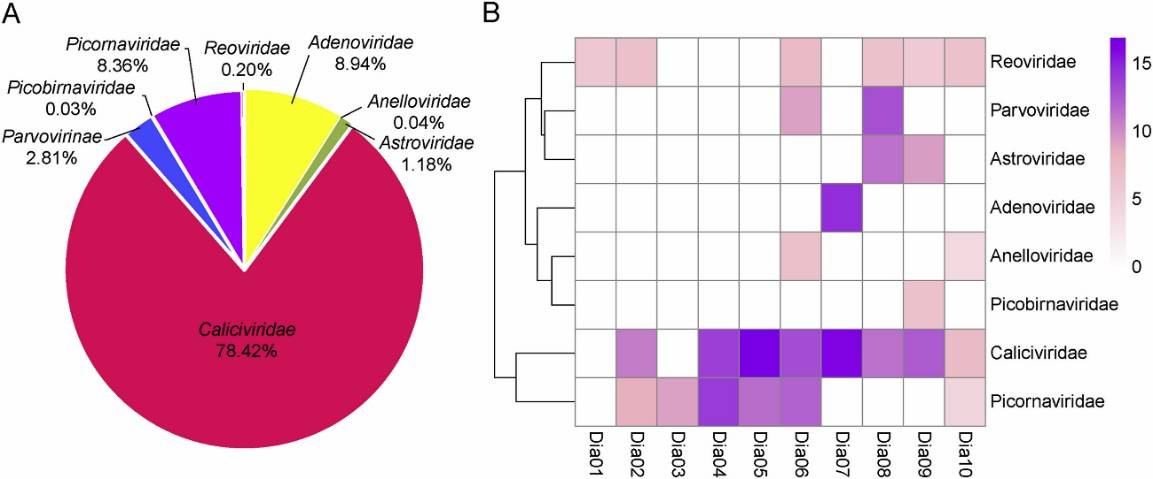 Fig. 1. Taxonomic analysis of fecal virome detected in diarrheal children on the family level. A The composition of fecal virome detected in diarrheal children. The percentage of virus sequences in different virus family was shown. B Heatmap representing the reads number of each viral family in exponential form.
Fig. 1. Taxonomic analysis of fecal virome detected in diarrheal children on the family level. A The composition of fecal virome detected in diarrheal children. The percentage of virus sequences in different virus family was shown. B Heatmap representing the reads number of each viral family in exponential form.
2. Phylogenetic analysis
In this study, nine viruses belonging to two genera of the Caliciviridae family were identified, of which eight were categorized as Norovirus (NoV), and one was part of the Sapovirus (SaV) genus. Seven viruses were under two genera of Picornaviridae, with three nearly full Enterovirus (EV) genomes and four almost complete sequences of Human parechoviruses. In addition, the presence of viruses belonging to the Mamastrovirus, Bocavirus, Mastadenovirus, and Rotavirus genera was also reported. This analysis expands the current knowledge of virodiversity in cases of paediatric diarrhoea.
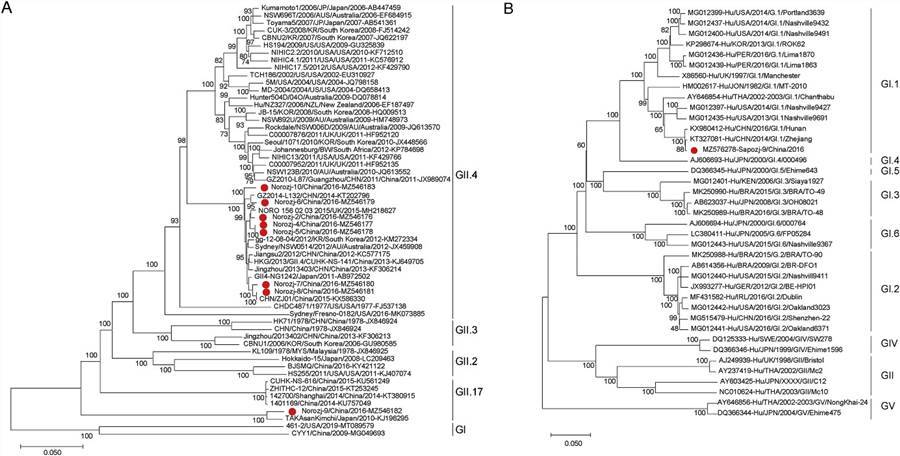 Fig. 2. The phylogenetic analysis based on the complete genome sequences of NoVs and SaVs.
Fig. 2. The phylogenetic analysis based on the complete genome sequences of NoVs and SaVs.
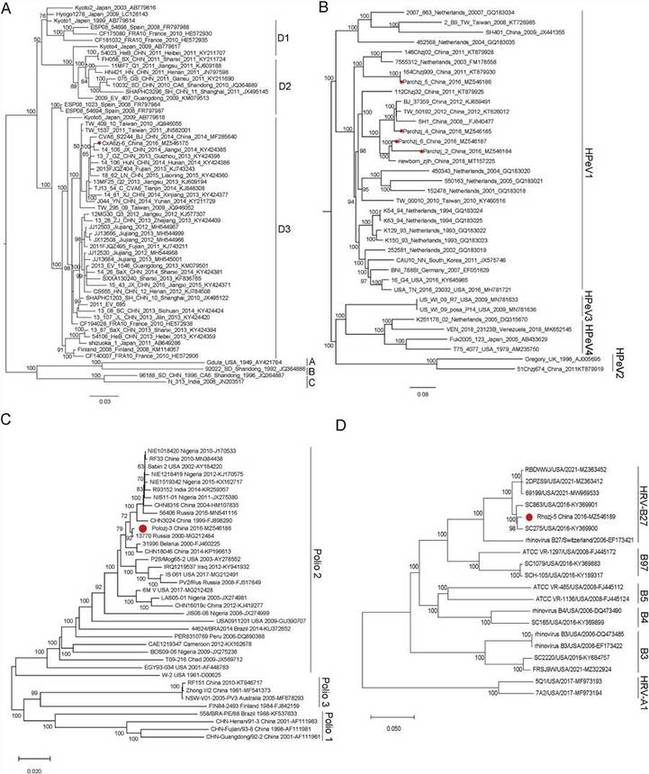 Fig. 3. The phylogenetic analysis of picornaviruses identified in this study.
Fig. 3. The phylogenetic analysis of picornaviruses identified in this study.
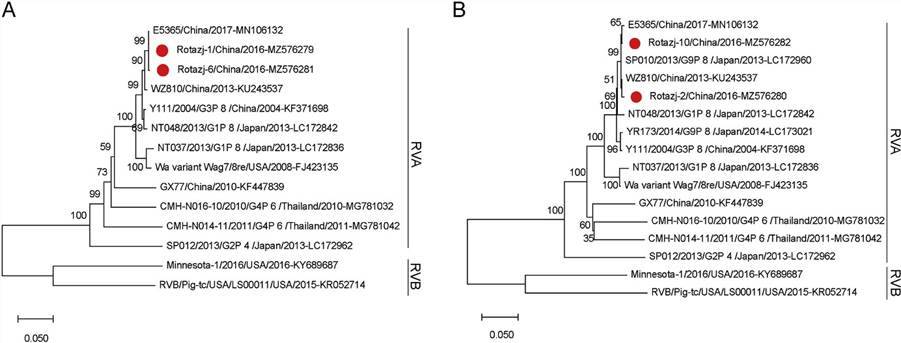 Fig. 4. The phylogenetic analysis of human rotaviruses identified in this study.
Fig. 4. The phylogenetic analysis of human rotaviruses identified in this study.
Conclusion
In this investigation, the researchers utilized viral metagenomic sequencing to analyze the viral communities present in fecal samples from children suffering from diarrhea. They observed that a significant proportion of DNA or RNA viruses associated with diarrhea belonged to six families: Adenoviridae, Astroviridae, Caliciviridae, Picornaviridae, Reoviridae, and Picobirnaviridae. Notably, Caliciviridae exhibited the highest prevalence at 78.42%, followed by Adenoviridae (8.94%) and Picornaviridae (8.36%). In addition to known pathogens implicated in human diarrheal diseases, the researchers identified unrelated viruses such as Circoviridae and Picobirnaviridae. This study advances our comprehension of the virome in pediatric diarrhea, furnishing valuable insights for the prevention and management of viral gastroenteritis.
References
- Braga L P P, Coutinho F H, Amgarten D E, et al. Novel virocell metabolic potential revealed in agricultural soils by virus‐enriched soil metagenome analysis. Environmental microbiology reports, 2021, 13(3): 348-354.
- Bai G H, Lin S C, Hsu Y H, et al. The human virome: viral metagenomics, relations with human diseases, and therapeutic applications. Viruses, 2022, 14(2): 278.
- Coutinho F H, Gregoracci G B, Walter J M, et al. Metagenomics sheds light on the ecology of marine microbes and their viruses. Trends in microbiology, 2018, 26(11): 955-965.
- Greninger A L. A decade of RNA virus metagenomics is (not) enough. Virus research, 2018, 244: 218-229.
- Jiang L, Lang S, Duan Y, et al. Intestinal virome in patients with alcoholic hepatitis. Hepatology, 2020, 72(6): 2182-2196.
- Mihindukulasuriya K A, Mars R A T, Johnson A J, et al. Multi-omics analyses show disease, diet, and transcriptome interactions with the virome. Gastroenterology, 2021, 161(4): 1194-1207. e8.
- Shixing Yang, Yumin He, Ju Zhang, et al. Viral metagenomics reveals diverse viruses in the fecal samples of children with diarrhea. VIROLOGICA SINICA, 2022, 37(1): 82-93



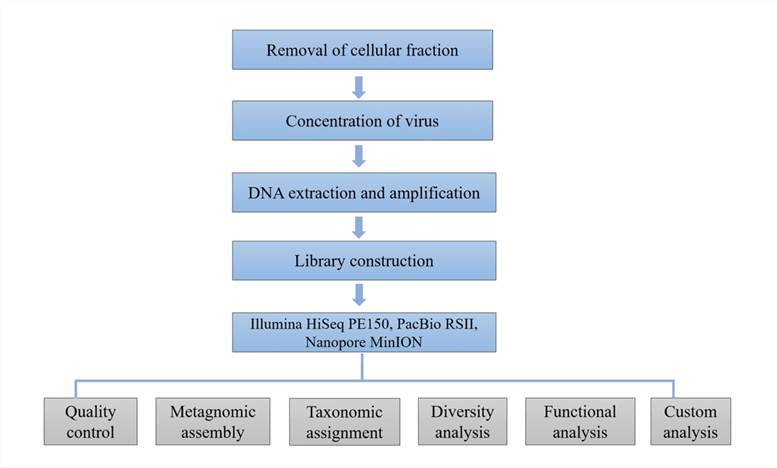
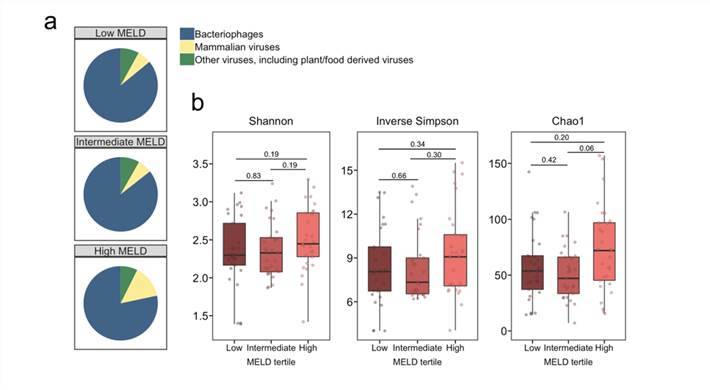
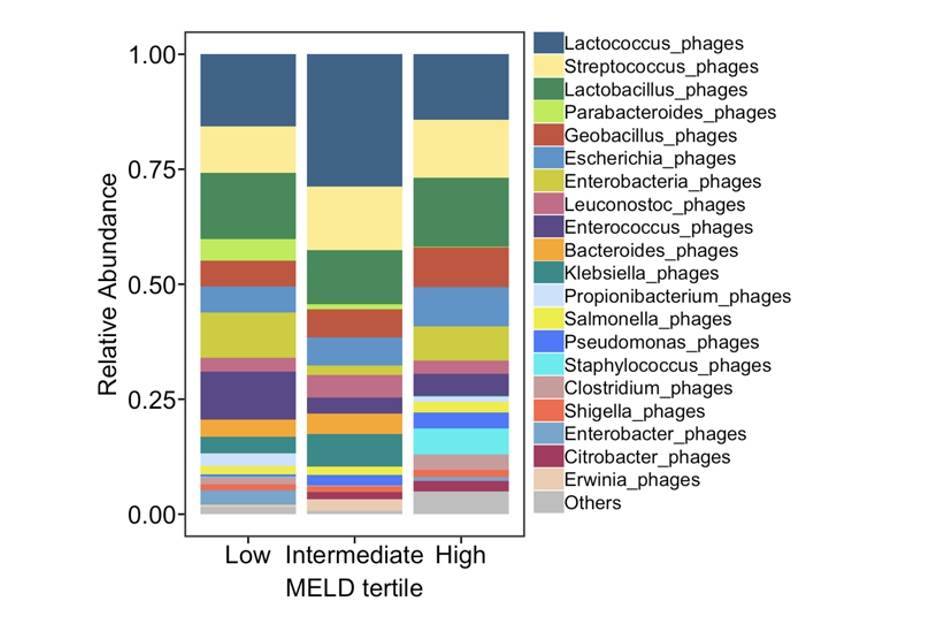 Intestinal virome in patients with alcoholic hepatitis. (Jiang et al., 2020)
Intestinal virome in patients with alcoholic hepatitis. (Jiang et al., 2020)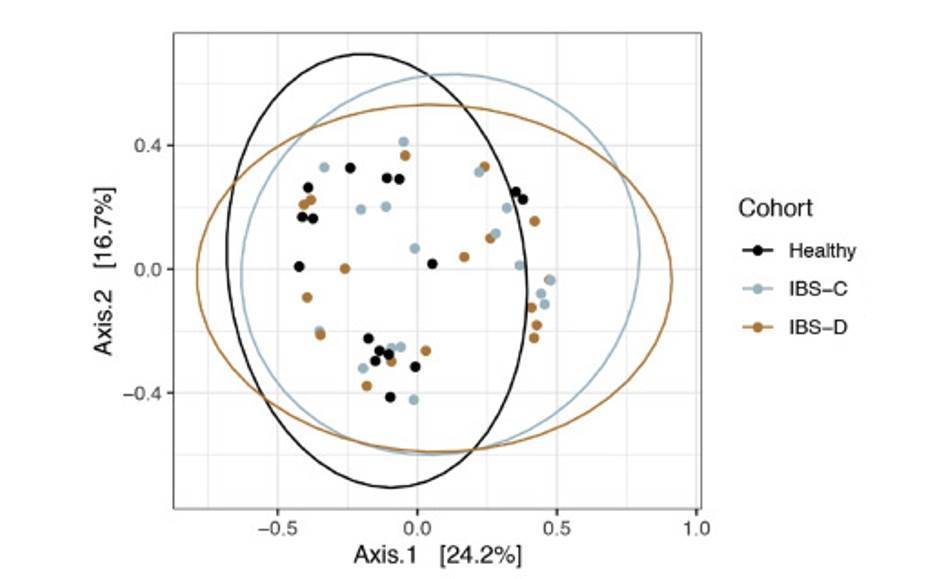 Multi-omics analyses show disease, diet, and transcriptome interactions with the virome. (Mihindukulasuriya et al., 2021)
Multi-omics analyses show disease, diet, and transcriptome interactions with the virome. (Mihindukulasuriya et al., 2021) Fig. 1. Taxonomic analysis of fecal virome detected in diarrheal children on the family level. A The composition of fecal virome detected in diarrheal children. The percentage of virus sequences in different virus family was shown. B Heatmap representing the reads number of each viral family in exponential form.
Fig. 1. Taxonomic analysis of fecal virome detected in diarrheal children on the family level. A The composition of fecal virome detected in diarrheal children. The percentage of virus sequences in different virus family was shown. B Heatmap representing the reads number of each viral family in exponential form. Fig. 2. The phylogenetic analysis based on the complete genome sequences of NoVs and SaVs.
Fig. 2. The phylogenetic analysis based on the complete genome sequences of NoVs and SaVs. Fig. 3. The phylogenetic analysis of picornaviruses identified in this study.
Fig. 3. The phylogenetic analysis of picornaviruses identified in this study. Fig. 4. The phylogenetic analysis of human rotaviruses identified in this study.
Fig. 4. The phylogenetic analysis of human rotaviruses identified in this study.



